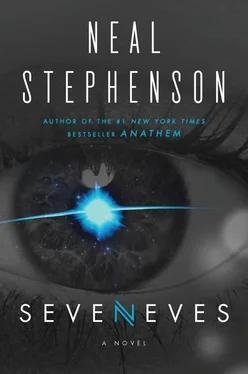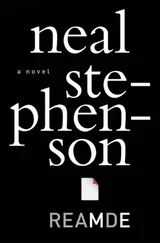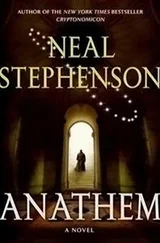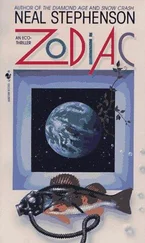“What does that mean exactly?”
“That the robot work would keep going. That I would have a job. I didn’t believe him. But I guess he’s been talking to Sean Probst. Because Sean FedExed these to Sparky a couple of days ago, and now they’re here.”
She parted the bag’s ziplock closure, inserted her thumb and index finger, and pulled out a contraption about the size of a grain of rice. From a distance it looked like a photovoltaic cell, just a flake of silicon, but with a few tiny appendages.
“What are the dangly bits?” Rhys wanted to know.
“A locomotion system.”
“Legs?”
“This one happens to have legs. Others have things like little tank treads, or rolling cylinders, or slammers.”
“Slammers? Is that a technical term?”
“A mining thing. A way of moving heavy equipment around on the ground. I’ll show you later.”
“So,” Rhys said, “it would appear that the agenda is to evaluate a number of different ways that robots could crawl around on ice without drifting off and getting lost.”
“Yeah. Apparently all of these work, more or less, on the ground in Seattle. I’m supposed to evaluate their performance in space.”
“Well!” Rhys said. “How fortunate for you, then, that—”
“That I have my very own chunk of ice. Yeah. Thanks for that.”
“All the sweeter for being contraband?” he asked, raising his eyebrows.
The double meaning was clear enough. “Not as romantic as a dozen roses,” she countered.
“Still,” he said, “what is it that a man is trying to say with a dozen roses? Simply that he is thinking of you.”
Shortly after she’d arrived on Izzy she had rigged up a curtain that she could draw across the opening of her shop’s hatch. It wasn’t much — just a blanket — but it shielded her visually when she wanted to take a nap in her shop, and it sent the message that she was not to be disturbed, at least without knocking first. She reached up now and drew the curtain across the hatchway. Then she turned back toward Rhys, who looked very keen, and very ready.
“How’s your space sickness?” she asked. “You seem a little more, uh, sprightly.”
“Never better. All bodily fluids fully under control.”
“I’ll be the judge of that.”
THE RUSSIAN INVASION BEGAN A WEEK LATER, WITH A SPATE OF flights producing what NASA described as “mixed results” and Roskosmos termed “an acceptable fatality rate.”
Seen from a distance, Izzy consisted almost entirely of solar panels. Structurally, these were to the space station as the wings of a bird were to its body, in the sense that their purpose was to have as much surface area as possible with minimal weight.
Most of the mass, strength, and brains were in the “body”—a stack of can-shaped modules running up the middle between the “wings”—which was tiny by comparison. From many angles you couldn’t even see it. The only parts of the stack big enough to be noticed from a distance were the add-ons from recent years: Amalthea at one end and the torus at the other.
The solar panels — as well as some other, vaguely similar-looking structures whose function was to radiate waste heat into space — were held in place by the Integrated Truss Assembly. The word “truss,” when used by structural engineers, just meant something that looked like a radio tower or a steel bridge: a network of struts joined into a lattice, giving maximum stiffness with minimum weight. In some parts of Izzy, those struts were visible, but more commonly they were covered up by panels that made them look more solid than they were. Behind those panels resided unfathomably complex wiring, plumbing, batteries, sensors, and mechanisms for deploying and rotating solar panels. With a few minor exceptions, none of the Integrated Truss Assembly was pressurized — none of it was meant to hold air or accommodate human beings. It was like the mechanical works on the roof of a skyscraper, exposed to the elements and rarely visited by humans. Astronauts went there on space walks to mess with the wiring or fix things that weren’t working, but most of Izzy’s crew spent their whole missions inside the much smaller stack of cans that made up the station’s “body.”
That was going to have to change.
Izzy herself could only expand so much. This was not a question of stacking on more cans, or adding additional tori. Beyond a certain point you simply couldn’t jam more complexity into such a focused volume. Electrical power was needed to run just about everything. Whenever it was used, waste heat was generated. The heat would build up in the space station and cook the occupants unless it was collected by a refrigeration system and piped out to radiators that would “shine” the heat, in the form of infrared light, into space. Jamming more people and systems into the central body of the space station would just require more solar panels, more batteries, more radiators, and more plumbing and wiring to connect them all. And this didn’t even address the human factors: how to supply people with food, water, and clean breathable air, and how to recycle carbon dioxide and sewage.
Knowing this, the brain trust behind the Cloud Ark — an ad hoc working group of governmental space agency veterans and commercial space entrepreneurs — had opted for the only strategy that could possibly work, which was decentralized and distributed. Each arklet, as the component ships were being called, would be small enough that it could be heaved into orbit on the top of a single heavy-lift rocket. It would draw power from a small, simple nuclear reactor fueled by isotopes so radioactive that they would throw off heat, and thereby generate electricity, for a few decades. The Soviet Union had used such devices to power isolated lighthouses, and they had been employed in space probes for decades.
Each arklet would accommodate a small number of people. The number kept changing as different designs were drawn up, but it meandered between about five and a dozen. Much depended on how rapidly it would prove feasible to mass-produce inflatable structures; these made it possible to create much more spacious volumes by housing people in what amounted to thick-skinned balloons. But making balloons that could withstand atmospheric pressure indefinitely while also standing up to solar radiation, thermal swings, and micrometeoroids was no small project.
It went without saying that, in the long run, the Cloud Ark as a whole was going to have to be self-sustaining in terms of food production. Water would have to be recycled. Carbon dioxide exhaled by humans would have to be used to sustain plants, which would produce oxygen for the humans to breathe and food for them to eat. All of this had been the subject matter of science fiction stories and practical experiments for decades. Those experiments had produced mixed results that were now getting a lot of attention from people who understood such things a lot better than Dinah. But she gathered that she had better get used to a low-calorie vegetarian diet, and occasional oxygen shortages.
Isolated arklets wouldn’t survive for long. It didn’t matter how good their internal ecosystems were. Things would go wrong, people would get sick, supplies and nutrients would run low, and people would just plain go crazy from being cooped up with the same few individuals.
The design of the arklets, and of the whole Cloud Ark system, kept changing. One day it was all about being “fully distributed,” which meant that in the long run there was no central depot — no Izzy — and that all exchanges of material and “human resources” between arklets would happen through “opportunistic docking,” meaning that two arklets would agree to come together and connect nose-to-nose for a time so that food, water, vitamins, or people could be exchanged. This was envisioned as market driven, without any central command and control mechanism.
Читать дальше
Конец ознакомительного отрывка
Купить книгу





